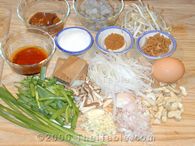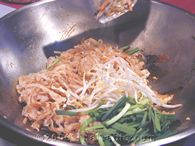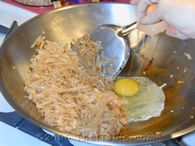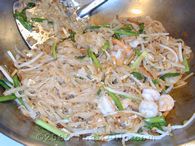PadThai
by Sue

Pad Thai - This Pad Thai recipe is how you actually find it in Bangkok and comes from testing hundreds of different variations from food carts all over the city. Pad Thai is the ultimate street food. While "street food" may sound bad, food cart cooks are in such a competitive situation, with such limited space, ingredients and tools they need to specialize in a dish or two just to stay in business. The best of these cooks have cooked the same dish day-after-day, year-after-year, constantly perfecting it.
Great Pad Thai is dry and light bodied, with a fresh, complex, balanced flavor. I've never actually seen the red, oily pad thai in Thailand that is common in many western Thai restaurants.
The ingredients listed below can be somewhat intimidating but many are optional. If you would like to make authentic Pad Thai, just like in Thailand, use all the ingredients.
Pad Thai is another perfect vegetarian dish, just omit shrimp and substitute soy sauce for fish sauce. Add more tofu if you like.
Ingredients for 2-3 Servings
1/2 lime
1 egg
4 teaspoons fish sauce
3 cloves garlic, minced
1/2 teaspoon ground dried chili pepper
ground pepper
1 shallot, minced
2 tablespoon sugar
2 tablespoon tamarind
1/2 package Thai rice noodles
2 tablespoon vegetable oil
1/2-1/4 lb shrimp Optional
1/2 banana flower Optional
1/3 cup tofu - extra firm Optional
1-1/2 cup Chinese chives - green Optional
2 tablespoons peanuts Optional
1-1/3 cup bean sprouts Optional
1 tablespoon preserved turnip Optional
Tips and substitutions
By far, the trickiest part is the soaked noodles. Noodles should be somewhat flexible and solid, not completely expanded and soft. When in doubt, undersoak. You can always add more water in the pan, but you can't take it out.
Method
Soak the dry noodles in lukewarm water while preparing the other ingredients, for 5-10 minutes. Julienne tofu and cut into 1 inch long matchsticks. When cut, the extra firm tofu should have a mozzarella cheese consistency. Cut up Chinese chives into 1 inch long pieces. Set aside a few fresh chives for a garnish. Rinse the bean sprouts and save half for serving fresh. Mince shallot and garlic together.
Use a wok. If you do not have
Pour onto the serving plate and sprinkle with peanuts. Serve hot with the banana flower slice and a wedge of lime on the side and raw Chinese chives and raw bean sprouts on top.
As always, in Thailand, condiments such as sugar, chili pepper, vinegar and fish sauce are available at your table for your personal taste. Some people add more pepper or sugar at this point.
Notes:
Shrimp can be substituted or omitted.
In this recipe, pre-ground pepper, particularly pre-ground white pepper is better than fresh ground pepper. For kids, omit the gound dried chilli pepper.
Tamarind adds some flavor and acidity, but you can substitute white vinegar.
The type of extra firm tofu called for this recipe can be found at most oriental groceries in a plastic bag, not in water. Some might be brown from soy sauce, but some white ones are also available. Pick whatever you like.
If you decided to include banana flower, cut lengthwise into sections (like orange sections). Rub any open cut with lime or lemon juice to prevent it from turning dark.
The original Pad Thai recipe calls for crushed roasted peanuts. Many people in Thailand avoid eating peanuts because of its link to cancer.







